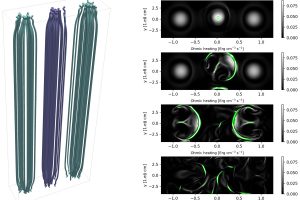Micro-flares and the problem of the coronal heating. The paper: “Coronal energy release by MHD avalanches. Effects on a structured, active region, multi-threaded coronal loop” of G. Cozzo (UNIPA) appeared on A&A

The corona is the outermost part of the Solar atmosphere, filled with plasma at temperatures reaching several million degrees. The mechanism responsible for heating the Solar plasma to these temperatures is a long-standing problem. It began in the 1930s when physicists Bengt Edlen and Walter Grotrian proposed that the mysterious spectroscopic lines observed in the corona were not due to a new chemical element called “coronium” (as believed for about 70 years) but rather to highly ionized atoms of iron and calcium. This idea was quite controversial at the time because it required an unknown source of energy in the corona capable of heating the plasma to temperatures in the millions.
After decades of research, it is now clear that the heating of the corona is attributed to the Solar magnetic field. The Sun indeed generates its own magnetic field, and several phenomena observed on the Sun are a result of the balance between magnetic and plasma pressure. In the corona, the dynamics are predominantly governed by the magnetic field, often organized in long loops with their bases anchored to the underlying photosphere. Within these loops, the magnetic field forms highly dynamic filaments known as “strains,” which twist due to the motion of their feet driven by the movement of the photospheric plasma. The energy stored in these magnetic fields is subsequently released locally when the magnetic field reconfigures itself to attain lower-energy configurations, a process referred to as “magnetic recombination“.
Astronomer G. Cozzo, from the University of Palermo, has recently presented magnetohydrodynamic (MHD) simulations aimed at studying the mechanism responsible for the release of energy within magnetic loops. The model tracks the evolution of two twisted flux tubes anchored in the photosphere, passing through the stratified solar atmosphere from the chromosphere to the corona. The filaments within the loops become unstable (experiencing kink instability, typical of plasmas in elongated configurations) after accumulating sufficient magnetic stress, causing them to modify their topology to attain lower-energy configurations. Subsequent magnetic reconnection events (MHD avalanches) induce localized energy releases, manifesting as “nano-flares“. These events occur rapidly, taking about 10 seconds, and they happen within small regions with a size on the sky smaller than 1 arcsecond. Nano-flares have already been observed (observations are detailed in this paper published in 2020, based on data from the Atmospheric Imaging Assembly, AIA, aboard the Solar Dynamics Observatory, and the Extreme-Ultraviolet Imaging Spectrometer, EIS, aboard the Hinode satellite). They will also be a core focus of future missions such as MUSE and SOLAR-C/EUVST. The simulations are described in detail in the paper titled “Coronal energy release by MHD avalanches: Effects on a structured, active region, multi-threaded coronal loop“, recently published in Astronomy & Astrophysics. Among the co-authors are astronomers F. Reale and P. Pagano from the University of Palermo and INAF – Astronomical Observatory of Palermo.
The figure (click here to view the entire image) displays the magnetic loops that are the subject of the simulations. The left panel shows the initial conditions of the loops, with the one characterized by faster twisting marked in purple. The right panel illustrates, in a transverse section, the heating at four different time points: 11200 seconds (onset of the kink instability), 11400 seconds, 11800 seconds (destruction of the two side loops), and 11900 seconds.
Mario Giuseppe Guarcello ( follow mariospiegacose) ( mariospiegacose) ( follow mariospiegacose)
Follow the Astronomical Observatory of Palermo on Facebok and on Instagram
Subscribe the Youtube channel of the Astronomical Observatory of Palermo
